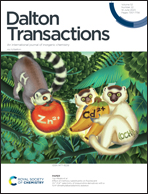Electrocatalytic water oxidation by heteroleptic ruthenium complexes of 2,6-bis(benzimidazolyl)pyridine Scaffold: a mechanistic investigation†
Abstract
Three monomeric ruthenium complexes with anionic ligands [RuII(L)(L1)(DMSO)][ClO4] (1), [RuII(L)(L2)(DMSO)] [PF6] (2), and [RuII(L)(L3)(DMSO)][PF6] (3) [L = pyrazine carboxylate, L1 = 2,6-bis(1H-benzo[d]imidazol-2-yl)pyridine, L2 = 4,5-dmbimpy = 2,6-bis(5,6-dimethyl-1H-benzo[d]imidazol-2-yl)pyridine, L3 = 4-Fbimpy = 2,6-bis(5-fluoro-1H-benzo[d]imidazol-2-yl)pyridine, DMSO = dimethyl sulfoxide] as electrocatalysts for water oxidation are reported herein. The single crystal X-ray structure of the complexes reveals the presence of a DMSO molecule, which is supposed to be the labile group undergoing water exchange under the experimental condition of electrocatalysis. Linear sweep voltammetry (LSV) and cyclic voltammetry (CV) study shows the appearance of the catalytic wave for water oxidation at Ru(IV/V) oxidation. LSV, CV, and bulk electrolysis technique has been used to study the redox properties of the complexes and their electrocatalytic activity. A systematic variation on the ligand scaffold has been found to display a profound effect on the rate of electrocatalytic oxygen evolution. Electrochemical and theoretical (density functional theory) studies support the O–O bond formation during water oxidation passes through water nucleophilic attack (WNA) for all the ruthenium complexes. At pH 1, the maximum turnover frequency (TOFmax) has been experimentally obtained as 17556.25 s−1, 31648.41 s−1, and 39.69 s−1 for complexes 1, 2, and 3, respectively, from the foot of wave analysis (FOWA). The high value of TOFmax for complex 2 indicates its efficiency as an electrocatalyst for water oxidation in a homogeneous medium.



 Please wait while we load your content...
Please wait while we load your content...